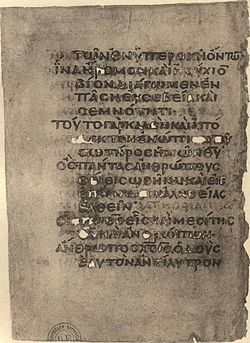1 Timothy 1
| 1 Timothy 1 | |
|---|---|

Fragments showing First Epistle to Timothy 2:2-6 on Codex Coislinianus, from ca. AD 550.
|
|
| Book | First Epistle to Timothy |
| Bible part | New Testament |
| Order in the Bible part | 15 |
| Category | Pauline epistles |
1 Timothy 1 is the first chapter of the First Epistle to Timothy in the New Testament of the Christian Bible. The author has been traditionally identified as Paul the Apostle as early as AD 180, although most modern scholars consider the letter pseudepigraphical, perhaps written as late as the first half of the second century AD.
This chapter can be grouped (with cross references to other parts of the Bible):
Vulgate Latin reads: "beloved son" (dilecto filio).
The "law" must be used "lawfully" or "legitimately", that is with the understanding of its purpose: the "function of the law in the lives of those who have been saved by grace". In this passage, Paul describes the actions that are contrary to the law, but not in "personal debauchery" (as in Galatians 5:19-21) but "in opposition to God" (1 Timothy 1:9a) and "in hostility to human beings" (1 Timothy 1:9b-10a), which show love to "neither God nor neighbor".
The word anomois (from the Greek: a-, meaning "not" or "without", and nomos, meaning "law" or "custom") is generally translated into English as "lawless", although NIV renders it "lawbreakers", while Douay-Rheims uses "unjust". Vincent defines it as "recognizing no law" rather than "not having a law".
This verse establishes that "the law has been made" not for the righteous but for "lawless/lawbreakers" and "disobedient/rebels"; the law is not applicable to the righteous as some heretics try to force it into "a doctrinal or ethical role it was not intended to have". The law functions as a kind of "vice list" to "point out sin in whatever form it may take in a given culture", exposing the false teachers who are misusing it. The "vice list" not only recalls the lists found in ancient moralistic writings, but follows the topics in the "Ten Commandments" (Deuteronomy 5:16-21), as in the following table:
...
Wikipedia
